
- OCD JOURNAL vol.4 no.1
- 2013.03.27
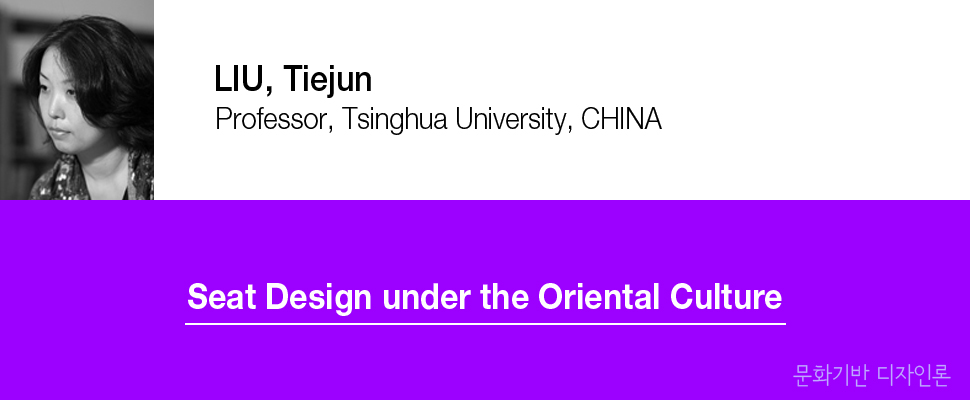
Keyword
Seat, Design, Oriental Culture
1. History of Sitting
Judging from the worldwide scope, mankind has two ways of "sitting": one is sitting on the ground, and the other is sitting with legs hanging down.
Sitting on the ground means that people spread a mat on the ground of the living space, when they sit, the body's main load bearing part touches the mat directly, and everything in their everyday life is carried out on the mat. Two thousand years ago, in Asia, including China, Korea Peninsula, Japan, India and so on, people's basic sitting mode was sitting on the ground. The genuflexion courtesy also originated from the life style of sitting on the ground and living on the mat. In the inscription on oracle bones, the Chinese character "人" (human) was a human shape on bended knees. Judging from other characters in the inscription on oracle bones, we can also find different sitting positions. The sitting history of Korea can be traced to the 4th century. In the mural of No. 3 Tomb of Goguryeo An Yue in the 4th century, the portrait of the female owner of the tomb was sitting on the flat couch, which was a posture of sitting on the ground, showing the status of the owner.
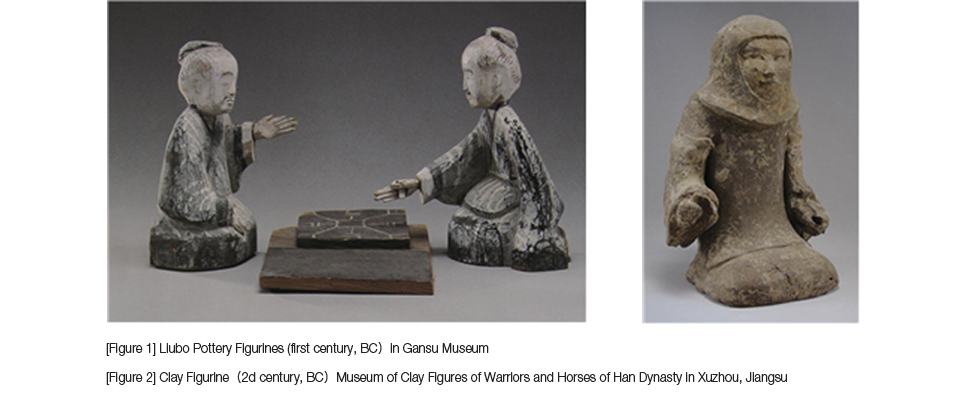
Sitting with legs hanging down refers to such a sitting manner: when a person sits, he uses his buttocks as the main supporting point to bear the weight of the whole body, the thighs are basically parallel to the ground the lower legs and the feet hang down naturally, and there is a certain distance between the sitting level and the ground. This sitting manner is also called "high sitting position". Furniture suitable for such a sitting position is characterized by high feet. People with such a sitting mode usually do not need to take off their shoes and go directly into the indoor space, thus, their everyday life has to rely on the high‐feet furniture. As early as three thousand years ago, the ancient Egyptians already used the mode of sitting with legs hanging down, and their form of the chair was quite mature then. So to speak, the sitting mode with legs hanging down originated from ancient Egypt, and then was spread to the vast areas of Europe and Asia.
In history, China experienced a transition from the mode of sitting on the ground to that of sitting with legs hanging down, and such a change in life style led directly to changes in the form and usage mode of the residence and the furniture. In the furniture developmental history of China, we experienced a gradual transition from low‐feet furniture combination to high‐feet furniture combination, and such a transition was very long, lasting more than one thousand years. Basically speaking, in the one thousand years from the Jin Dynasty and the Northern and Southern Dynasties to the North Song Dynasty, there were both sitting on the ground and sitting with legs hanging down in people's life, so, in that period, furniture was also in a mixed style. The sitting style with legs hanging down was completely fixed in the Northern Song Dynasty. In the Sui(隋) and Tang(唐) dynasties, standing‐typed furniture was used only by a few people of the royal family and the nobility; by the Song Dynasty, it was already spread to all the strata of the society, and even common people could use this type of furniture. In terms of time, sitting on the ground was much longer than sitting with legs hanging down.
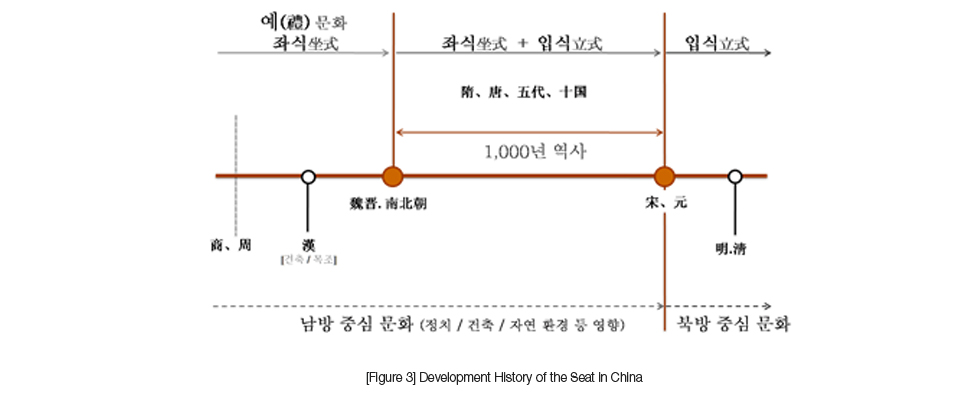
图中文字:
隋、唐、五代、十国Sui, Tang, Five Dynasties and Ten Kingdoms
坐式 horizontal style
立式 vertical style
魏晋、南北朝 Wei and Jin Dynasties, and Southern and Northern Dynasties
商、周 Shang and Zhou Dynasties
汉 Han Dynasty
宋、元 Song and Yuan Dynasties
明、清 Ming and Qing Dynasties
2. Types of Sitting
There are many types of sitting position: "guizuo (sitting on heels)", "qizuo (sitting like a dustpan)”, "panzuo (hunkering)”, "dunzuo (squatting)", "jiafu zuo", "qizuo", etc.

图中文字:
跪坐 guizuo
盘坐 panzuo
箕坐 jizuo
蹲坐 dunzuo
跂坐 qizuo
In ancient China, the most normal sitting position was called "guizuo (sitting on heels)",but Japanese called it "seiza (right sitting)", which was introduced to Japan from China through Korea Peninsula. "Guizuo (sitting on heels)" means such a posture: the person bends his two knees,with his two lower legs and two feet bearing the weight of his whole body,and with his buttocks resting on his feet. It is also called "weizuo(危坐)".People keeping the life style of sitting on the ground usually needed to take off their shoes before entering the indoor space,and everything in their everyday life was done on the mat on the ground, including sleeping, eating, guest receiving, resting, studying, singing and dancing, sacrificial ceremony and so on. Hence, they have developed a whole set of habits, customs and ceremonies suitable for this style of sitting.
"Qizuo (Dustpan‐styled Sitting)" refers to such a sitting position in which the buttocks touch the ground, the two legs are stretched straight and parallel to the ground.
"Panzuo (hunkering)" means tucking up the legs, with the buttocks touching the ground, the two legs separated and bent, and the two feet pressed under the two thighs crosswise. Hunkering was regarded as an inelegant sitting position for ancient Oriental females. In Korea and Japan where the mat feast protocol is still kept, "hunkering" has become a common sitting position for males in modern Korea and Japan,but for females, on a normal occasion, they still use the mode of sitting on heels or the mode of sidewise sitting on heels.
"Jiafu zuo" was the sitting position for the Buddha to preach or do self cultivation in ancient India. In this sitting position, both sols should face upwards, placed on the thigh of the other side. It is the highest class of sitting position in Buddhism.
"Dunju (Crouching)" refers to squatting,with the feet touching the ground, and the body crouching down. It was the oldest sitting position of mankind, with the greatest possibility to keep the body temperature. In the period of the mode of sitting on the ground in China, it was regarded as an informal sitting position.
“Qizuo” is also called ”cuizu zuo”. When a person sits, he uses his buttocks as the main supporting point to bear the weight of the whole body, the thighs are basically parallel to the ground, the lower legs and the feet hang down naturally and there is certain distance between the sitting level and the ground. This sitting position is also called “high sitting position”. In the times of sitting on the ground in China, "cuizu zuo" was regarded as the most impolite barbarous way of sitting.
3. Forms of the Seat
3.1 Use of Low Seats
In the times of sitting on the ground, people gradually realized that when people sat on heels on the ground for a long time,the cold moisture on the ground would invade the body,being harmful to the human body. Thus, people added a cushion and formed the "feast mat" system centering around the "courtesy", which exerted an influence on the fashion of the clothes, the style of the house, the system of measurement and so on. In the house, the building ground was raised up, and there was a certain distance between the building ground and the outdoor ground, so as to facilitate the air circulation, and result in a house pattern of dry‐column construction. When people sat on heels, the knees and the lower legs' shinbones touched the ground and bore the weight of the whole body, so, when they had sat for a long time, they would feel very tired. In order to mitigate the pressure of the body's weight on the buttocks, people invented a kind of furniture called "pingji (凭几)". It was a sort of furniture for people to lean against when they sit on the ground. Its height was as high as the armpit when people were sitting on heels. When people sat on heels or hunkered for a long while, they could lean against it, which had a certain supporting function to the person, so as to relieve the pressure of the body weight on the knees. In the Han Dynasty of China, pingji was often put on the level bed or the couch. There was also a sitting furniture called "ta (榻)",and it was a low seat for people to sit or lie. There were different sizes of ta, some being for a single person, and some being for two persons. The ta (couch) was a symbol of the person's status or class.
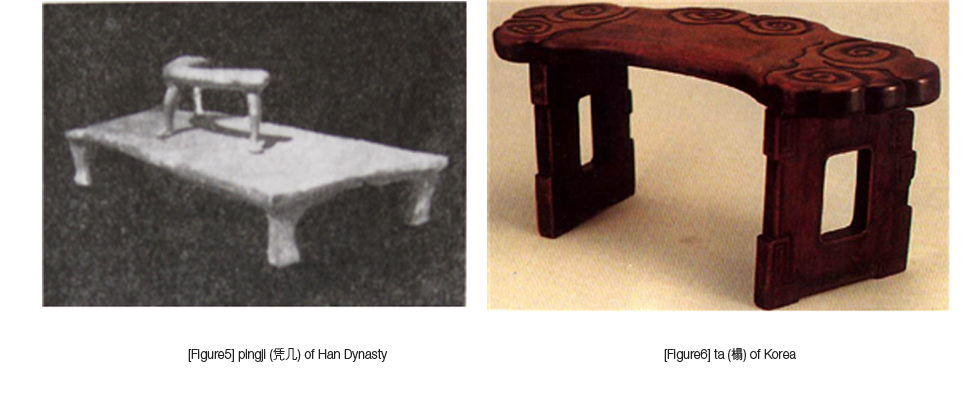
In the Chosun Period of Korea, the sitting tool was usually a square, only for one person to sit, with a size of 50CM or so. The outer covering material of it was usually a cloth, with a soft filler such as cotton or fur inside. In the Chosun Period, there was also a sort of furniture similar to "pingji(凭几)", which was a kind of furniture for leaning when sitting on heels. Moreover, there was a furniture combination with the level bed as the center; the level bed was a double‐duty tool for both sitting and lying, corresponding to the ta of China.
3.2 Use of High Seats
In ancient Egypt (B.C. 3100 ‐ B.C. 475),people already adopted the mode of sitting with legs hanging down. In the tomb of the Egyptian pharaoh Tutankamen 3,500 years ago, we have unearthed many elegant sitting chairs, whose form was already quite mature,very similar to the chair of modern times. In ancient Egypt,using a chair with a high back was only a privilege of the pharaoh and the nobility, and the chair symbolized the royalty and the social class. Hence,the original meaning of the chair was completely beyond its functions of use, as people endued it with many symbolic meanings far beyond its usability, taking it as a symbol of the user's power and status.

In China, the earliest high sitting tool was called "jiaowu (交兀)" or "hudeng (胡凳)(stool of the Hu nationality)",which was introduced from the West in the Western Han Dynasty. Only a very few people used it at that time. The high seat furniture system was completed in the Northern Song Dynasty. The middle stage of the Ming Dynasty was a period of great development of the high seat furniture. From the Ming Dynasty to the earlier stage of the Qing Dynasty, Ming‐style furniture of hardwood came into being. In that period, there were many kinds of sitting furniture, such as deng (stool), dun (frusta), chair, ta and so on. The chairs fell into many different kinds, too, such as denggua chair (lantern‐hanger‐styled chair), guanmao chair (official‐cap‐styled chair), rose‐styled chair, Zen chair, lying chair, round‐backed chair, armchair. People of different statuses used different chairs,and the functions of use of the sitting tools were classified very finely. The guanmao chair and the round‐backed armchair were used for formal occasions. The Zen chair was used when people were practicing meditation. Its size was very big, so as to meet the need for hunkering or jiafu sitting. The lying chair was used for men only to have a rest. The rose chair was smaller, usually used for informal occasions or for females.
In the period of the Ming Dynasty and the Qing Dynasty, the " ondol(hot floor)" in the siheyuan (courtyard with buildings on four sides) of Beijing was a building heating facility associated with the high sitting tool for sitting with legs hanging down. At the same time, it had a furniture function. It was closely related to the building construction. The interesting thing was: on the ondol, people took the manner of sitting on the ground. The " ondol" is a mixture of sitting on the ground and sitting with legs hanging down.
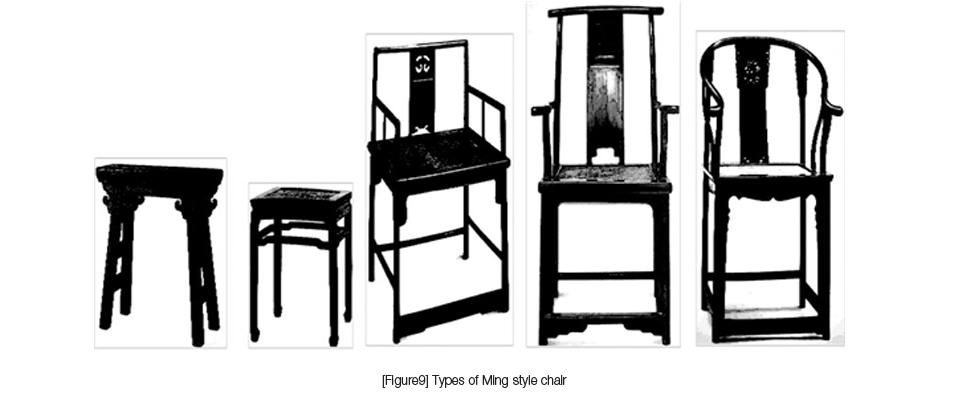 4.About My Design
4.About My Design
4.1 Different Styles of Sitting
By studying the two sitting styles, namely sitting directly on the ground and sitting with legs hanging down, I try to find a bonding point between two life styles, which can meet the need for sitting with the legs hanging down and also be used as tea table when people sit directly on the ground.
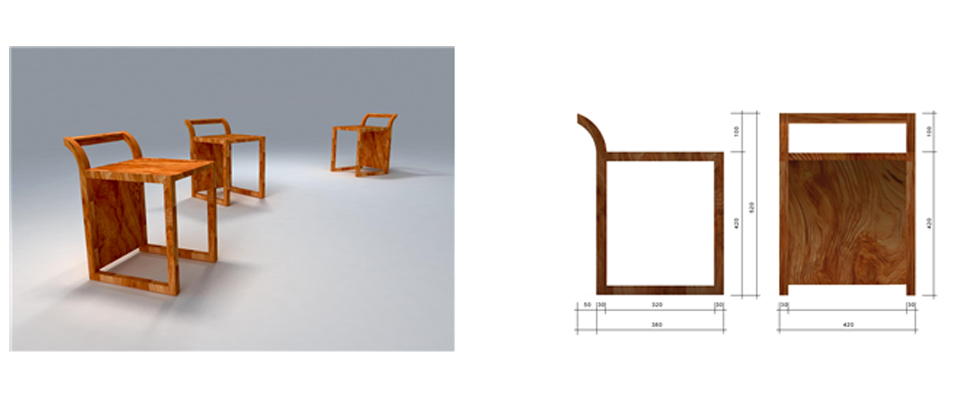
4.2 Annual Ring
In the life of men of letters in ancient China, people lived and wandered in a landscape‐styled residence, watching the drizzle dropping from the eaves while tasting the green tea in a leisurely manner, during which the time was prolonged and the space was expanded. My design just takes such an artistic conception in life as the starting point, and the annual ring can be understood as the cumulation of time, the cumulation of space and the cumulation of life.
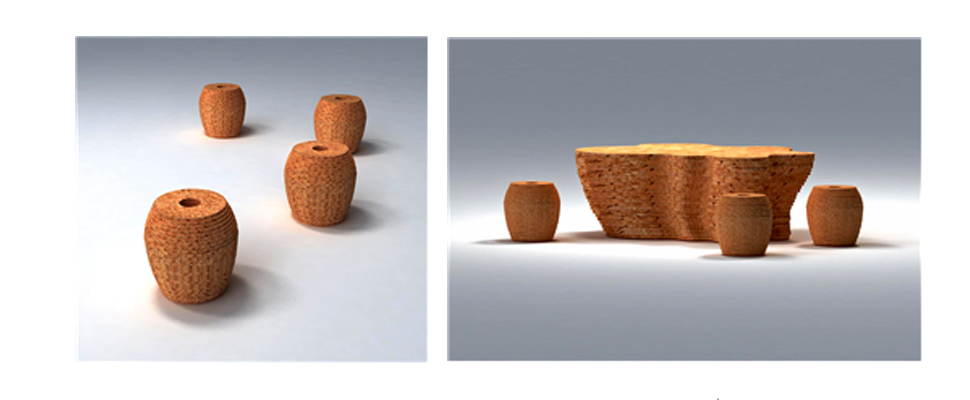
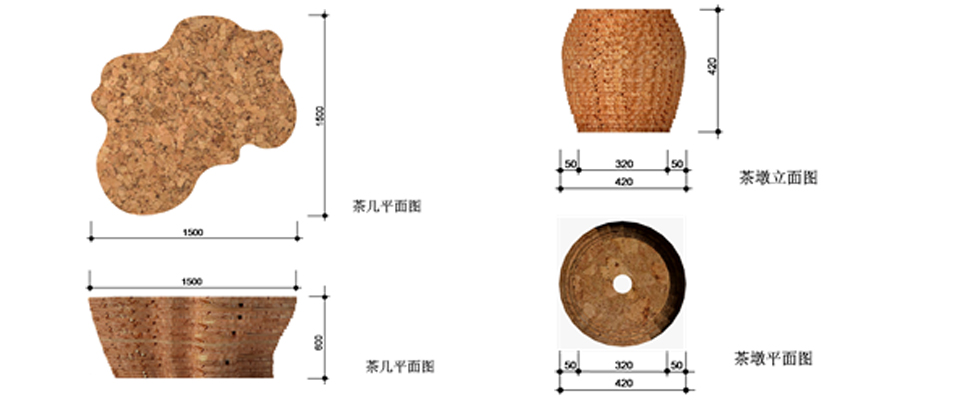
- JOURNAL
- CONFERENCE
- WORKSHOP
- EXHIBITION
- PUBLICATION
- OD BRAND
- ACTIVITY
- NEWS







